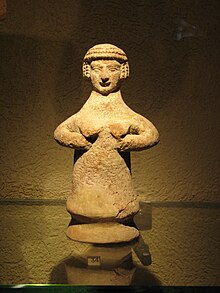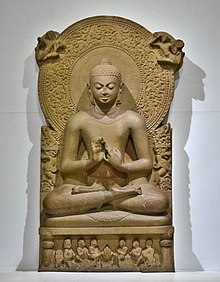Cult image
Cult images or cult images are pictorial representations that enjoy special reverence in religious cult activities. They can represent a deity , its symbol or higher beings, but also religiously significant people , events or scenes.
Cult images in the ancient Orient
Mesopotamia
Israel
The use of cult images of the Astarte and other deities in the folk cult in Israel has been archaeologically proven many times. Astarte figurines in particular have been found in numerous residential buildings with house altars. During excavations south of the Temple Mount in Jerusalem, more than 2,000 such figurines were found, all of which were broken into small pieces. Archaeologists and biblical scholars suggest that the destruction related to religious reforms and the installation of a central temple in Jerusalem in the late 7th century BC.
Egypt
see also: Cult in the ancient Egyptian religion
Cult image in Christianity
While in many earlier cultures and antiquity the cult images or statues of the deity or the worshiped were equated and worshiped as such , Judaism rejected this as idolatry . The Mosaic ban on images also applied in early Christianity , but monograms and sacred symbols such as cross , fish , shepherd or lamb were often used here. When images became more representational in the 3rd century, there were repeated disputes between supporters ( iconodulism ) and iconoclasts ( iconoclasm ). Uniform rules for iconolatry decided the Council of Nicaea (787): worship should be representations of Christ, Mary and the saints, worship , only the Trinity .
In the Orthodox churches , the cult images in the form of icons have since played an important role in worship . Above all Christ and the Mother of God Mary are depicted , but also angels , saints and figures from the Old Testament . The form of representation and religious meaning of the images is usually determined by traditional symbols of the icon schools . Worship is customary through kissing, squatting, and incense. Expression of the worship of icons is u. a. the iconostasis between the altar and the parish room.
In the Catholic Church , the forms of representation are freer and their details are left to the respective artist. Worship is neither recommended nor part of the worship service and is therefore silent. In general, the Protestant Church has no worship of images.
Buddhism
Early Buddhism also strictly rejected any form of image worship (see e.g. Sanchi or Bharhut ) and only knew symbolic representations for Buddha ( stupa , umbrella, wheel, tree, etc.). The first smaller Buddha images (e.g. on the bimaran reliquary ), which served as an iconographic and artistic model for the later larger Buddha statues, were not made until the turn of the century . There are standing, seated ( lotus seat or “European seat”) or reclining Buddha images, which are always dressed in an often wafer-thin robe. The half-closed eyes of the enlightened one, his various hand gestures ( mudras ), the drooping earlobes and a bun ( ushnisha ) are important for Buddhist iconography .
A richly painted world of images inside the places of worship, which was originally intended to help the monks and pilgrims to meditate , was created in northern India (e.g. in Ajanta ) and later in Tibet ; in the early cave monasteries , however, it was also used to beautify the bare rock faces.
Buddha images are venerated through individual flower gifts from the believers (garlands, flowers) and incense sticks ; in Tibet or in Southeast Asia , gold leaf is sometimes also applied . Community prayers or chants with drums and trumpets are an exclusive affair of the monks; ordinary believers do not participate. Religiously motivated mass events such as pilgrimage festivals etc. and sacrificial ceremonies generally do not take place.
Jainism

Similar to Indian Buddhism, the worship of gods plays no role in Jainism , which arose around the same time ; Rather, both Buddha and the Tirthankaras were and are viewed as exemplary spiritual guides who, through penance exercises, reflection and meditation, succeeded in finding a largely intellectual and non-violent path through life. The statues of the Jain Tirthankaras are characterized by immobility (especially in Bahubali ), complete nudity, elongated earlobes, half- or wide-open eyes and a breast jewel, which symbolizes their inner purity. The Jains' cult images, either in temples or often attached to rock walls, are venerated, but there are no pronounced sacrificial ceremonies, although incense sticks are sometimes lit or petals are scattered. Community ceremonies that go beyond the family setting are usually unknown; only in a few important pilgrimage sites such as B. in Shravanabelagola , larger ceremonies take place every several years.
Hinduism
In the mythology of Hinduism , as well as mandalas, pictorial, detailed depictions of deities ( devas ) and demons ( asuras ) play a major role. The picture in the temple or on the house altar conveys the divine presence and should lead to inner vision ( contemplation ). Ceremonies with the cult images are also common, such as pouring over or bathing, ointments, smoking and eating.
The deities are often represented with many arms (more rarely with several heads) to indicate their abilities and powers. Indications for this are given in Indian mythology in the writings of the Puranas . A very frequently depicted goddess is Kali ; The temple images of Vishnu , Shiva or Durga are the subject of special rites, for example through the use of a fragrant flower. The rivers Ganges and Yamuna, worshiped as female deities, are also important .
In view of the numerous deities of Hinduism, a clear identification is desirable. For this purpose, mounts ( vahanas ) were assigned to the main gods ; in addition, they were given typical, often weapon-like attributes (e.g. trishula , gada , chakra etc.).
Some schools like Shaivism reject cult images and statues (see lingam ), but accept them as a prayer aid for the common people.
The Hindu cult images in the cellae ( garbhagrihas ) of the temples are often supplied with sweet dishes or (coconut) milk by the believers, which, however , may only be given by the Brahmins . In a few temples (e.g. in Dakshinkali , Nepal) animal sacrifices are still offered.
Meso and South America
Toltecs , Aztecs , Zapotecs , Maya as well as all other sedentary cultures of Mesoamerica revered cult images in their temples - mostly at the top of high pyramids - which should be favorably attuned by "priests" with smoke , animal and human sacrifices . The people were not allowed to enter the temples; it watched the goings-on from the great ceremonial places. Most of the "idols" made of stone or ceramic were destroyed in the course of the Spanish conquest of Mexico . The same applies to the South American Inca Empire , whose predecessor cultures had long since perished.
See also
- Image worship , idol
- Puja in Hinduism and Buddhism
literature
- Valentin Müller : cult image. In: Paulys Realencyclopadie der classischen Antiquity Science (RE). Supplementary volume V, Stuttgart 1931, Col. 472-511.
- Hans Belting : Image and cult: a history of the image before the age of art. CH Beck, Munich 1990.
- Leonhard Küppers : Divine Icon. From the cult image of the Eastern Church. Düsseldorf: Bastion 1949.
- Patrick Schollmeyer : Roman temples - cult and architecture in the Imperium Romanum . Darmstadt 2008.
- Manfried Dietrich and Oswald Loretz : Jahwe and his Aschera . Anthropomorphic cult image in Mesopotamia, Ugarit and Israel. The biblical ban on images. Münster: Ugarit Verl. 1992. (Ugaritisch-Biblische Literatur Series. Vol. 9.) ISBN 978-3-92712008-2
- Monika Zin: The change of the Buddha image in the Buddha image. At the beginning of the Buddha image. In: Schmidt-Leukel u. a. (Ed.): Who is Buddha? A figure and its meaning. Diederichs, Munich 1998, ISBN 3-424-01418-4 .
- Anneliese and Peter Keilhauer: The Imagery of Hinduism. The Indian world of gods and their symbolism. DuMont, Cologne 1986, ISBN 3-7701-1347-0 , p. 35ff.
Individual evidence
- ↑ Avraham Negev: Finds and Treasures in the Land of the Bible , Calwer Verlag, Stuttgart 1978, p. 73
- ↑ Anneliese and Peter Keilhauer: The visual language of Hinduism. The Indian world of gods and their symbolism. DuMont, Cologne 1986, ISBN 3-7701-1347-0 , p. 35ff.



